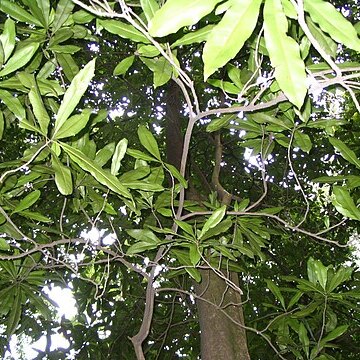Evergreen, buttressed trees or treelets growing monopodially with flushes, glabrous. Branches ascending. Bark brownish, finely fissured, rich in tannin; younger parts smooth. Stipules caducous, free, scale-like, about obliquely triangular, entire, acutish, glabrous. Leaves simple, spirally arranged, with slightly incrassate, entire or glandular-serrate margin, pinnately nerved, mostly obovate, tapering towards the base into a short petiole; midrib sulcate above, prominent beneath; venation obscure or slightly prominent on both surfaces; reticulations fine, irregular. Inflorescences axillary, dichasially corymbose. Peduncle smooth, glabrous; primary axes paired or sub-4-whorled, secondary axis paired, otherwise as the primary ones but usually much shorter; bracts scale-like, triangular, persistent, acutish, entire, smooth; bracteoles absent. Flowers bisexual, 5-merous, actinomorphic, perigynous. Young buds sticky. Calyx and corolla indurated and persistent in fruit, increasing in size. Sepals connate for up to 0.2 of their length, quincuncial, glabrous, fleshy to coriaceous in fruit. Petals quincuncial, almost free, glabrous, distinctly veined. Stamens 10 or (15-)20, in one whorl; filaments inserted outside and against the disk, irregularly coiled in bud, glabrous, subpersistent; anthers (basi-)dorso-versatile with a large peltate connective, introrse with 2 longitudinal slits, finely verrucose. Disk well-developed, bowl-shaped, with free margin, erect, entire or slightly lobed. Ovary superior, 5-celled, glabrous. Ovules! per locule, axile, one on each margin of the carpel, collateral, pendulous, epitropous. Style 1, irregularly coiled in bud, either elongating to 25 mm or remaining very short (up to 2.5 mm in /. petiolaris), glabrous, subpersistent in fruit; stigma mushroom-shaped, margin slightly lobed, fleshy. Capsule septicidal and septifragal, 5-celled, 5-valvate, without a central column, ovoid-conical or ellipsoid, acute or obtuse, glabrous, smooth; valves sometimes ultimately apically bifid, in transverse section W-shaped; exocarp sometimes fibrous and subtended by a thin membrane (hypoderm) folding along the septs and apparently into the 5 epicarp clefts; mesocarp dark, spongy; endocarp glossy. Seeds 1 or 2 per cell, either with a basal wing or with a suprahilar arillode; testa tenacious, brown; endosperm spongy, white, containing oil; embryo straight, ± half as long as the dorso-ventrally appressed, ± asymmetrically elliptic cotyledons. Germination epigeal.
More
Trees. Stipules small, scalelike. Leaves alternate, simple; leaf blade pinnately veined, margin entire or glandular serrate. Inflorescences axillary near branch apex, dichasially corymbose. Flowers bisexual. Sepals 5, basally connate, persistent, expanded and fleshy to leathery in fruit. Petals 5, persistent. Stamens 10 or 20; filaments inserted outside and against disk, irregularly coiled in bud, elongating at anthesis; anthers verticillate, 2-celled, dehiscent by longitudinal slits. Disk bowl-shaped, entire or slightly lobed, free from ovary. Ovary superior, 5-locular, placentation axile, with 2 pendulous ovules per locule; style 1; stigma capitate or mushroom-shaped, margin slightly lobed. Capsule oblong or conical, leathery or woody, septicidal, sometimes with a false septum at middle of each carpel. Seeds winged or crowned with a mitriform aril; endosperm fleshy; embryo straight.

